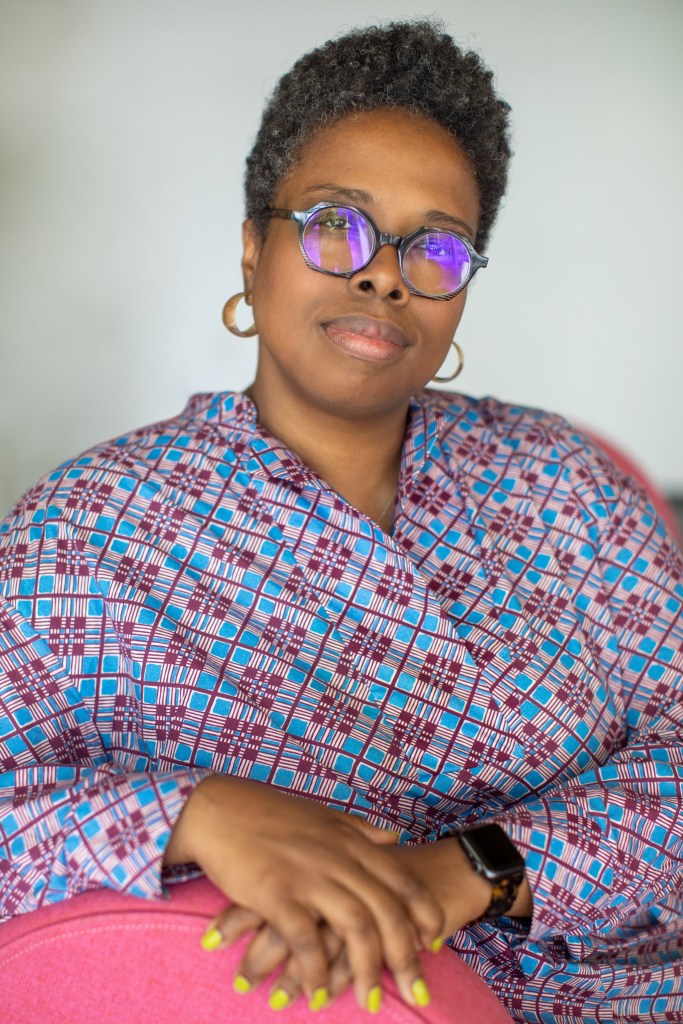“The Living End: Painting and Other Technologies, 1970-2020,” which opens November 9 at the Museum of Contemporary Art, as with so much of our lives, begins with the Internet. Specifically, with MCA Manilow senior curator Jamillah James, who observed the Internet’s effects on artistic practices in the early 2000s, and who organized the show with assistant curator Jack Schneider.
In 2010 James was living in New York City and observing two trends in the visual arts: the breakdown of traditional painting and the rise of “surf clubs,” or collaborative models of working in online spaces. This moment felt, to James, like another turning point in the long history of painting’s evolution in response to new technology. Just as artists had done upon the introduction of photography in the 19th century, or video in the 1960s—in the 21st century, prompted by the Internet, they were once again reconsidering more traditional forms.

Credit: Maria Ponce
The idea for the exhibition became more real in 2020, when it was originally planned for the Institute of Contemporary Art in Los Angeles, where James was working. The COVID-19 pandemic foreclosed that possibility, but that moment too felt significant as James observed artists experimenting with NFTs and AI.
Now the culmination of James’s decade-and-a-half-long consideration of the relationship between painting and other technologies has culminated in “The Living End.”
It’s a show that James says is “both of and about painting.” It reconstructs the longer history of how artists have responded to computers, cameras, and television, as well as, more recently, social media and automation, and how they have incorporated these technologies into their painting practice, adopted their aesthetics, or used them to grapple with the history of painting itself. Eighty percent of the works on view are of the titular medium, painting, but video and performance are also present because the real undercurrent of the show is technology as art’s inspirational “spark.”
“The Living End” will be organized thematically and chronologically, beginning with work made with and about early computing technologies, before moving through work in dialogue with television, the televisual, and performance and video.
For James this is the heart of the exhibition and, she expects, is what will surprise audiences the most. “There is a long history of artists working in performance and video having a lot to say about more traditional forms and the hierarchies [of art] that are formed in the public imagination,” James notes. “When you talk to someone about art, typically the brain goes to painting or sculpture, not necessarily to performance or video.”

Courtesy of the Estate of John Baldessari © 2024
The show includes work by legendary artists like John Baldessari, Carolee Schneemann, and Shigeko Kubota, all of which respond in one way or another to the history and ideology of painting. Included in the show is Schneeman’s Up to and Including Her Limits (1976), a video documenting a performance in which the artist responds to the masculine legacy of “action painting” by raising and lowering herself via harness to produce a series of marks on paper. The video transforms the ephemeral act of mark-making into a durational experience while inserting the female body as a creative force directly into the space and history of painting.
From there the exhibition moves into sections on photorealism, the Internet, and automation. Work by contemporary artists such as Petra Cortright, who creates work in Photoshop and other digital image software that is then printed on aluminum, and Wade Guyton, who manipulates the surface of the canvas using an Epson printer, will both be on view.

Courtesy MCA
Most of the show’s practice-based themes—an interest in critique, in removing the artist’s hand, or using one medium to creatively realize another—are not new in the history of art. What will be new is the way in which James brings these ideas together in the interest of thinking specifically about the history of one of art’s oldest mediums.
The exhibition is as much in dialogue with other shows from the last few years that have focused on the relationship between art and the Internet, or art and screens, as it is to recent shows about contemporary painting. Shows such as the MCA’s “I Was Raised on the Internet” (2018), which featured some of the same works that will be on view here, or the Modern Art Museum of Fort Worth’s “I’ll Be Your Mirror: Art and The Digital Screen” (2023), come to mind.
This is a history that is very much still being written, but “The Living End” cuts off at 2020 because, as James notes, she wanted “to contend with the history that leads up to this point.”
“I’m interested in precedent and trajectory, as opposed to just focusing on the immediate present,” she says. “I didn’t just want to focus on the digital as it relates to painting. I wanted to set the stage towards that moment and locate the precedent for what is happening now. I’m trying to establish a history of artists exploring painting as it relates to new technology.”
For over a century, artists and critics have been eager to declare the death of painting. For just as long museums have mounted exhibitions to prove them wrong. James is, thankfully, less interested in entering these debates than she is in expanding how we think about the medium beyond its status as endangered.
“The Living End: Painting and Other Technologies, 1970-2020”
Through 3/23/25: Tue 10 AM-9 PM, Wed-Sun 10 AM-5 PM, Museum of Contemporary Art Chicago, 220 E. Chicago, visit.mcachicago.org/exhibitions/the-living-end-painting-and-other-technologies-1970-2020/, suggested admission $19 Chicago residents, $10 Chicago students, teachers, 65+, $22 non-Chicago residents, $14 non-Chicago students, teachers, 65+, free on Tuesdays for Illinois residents






